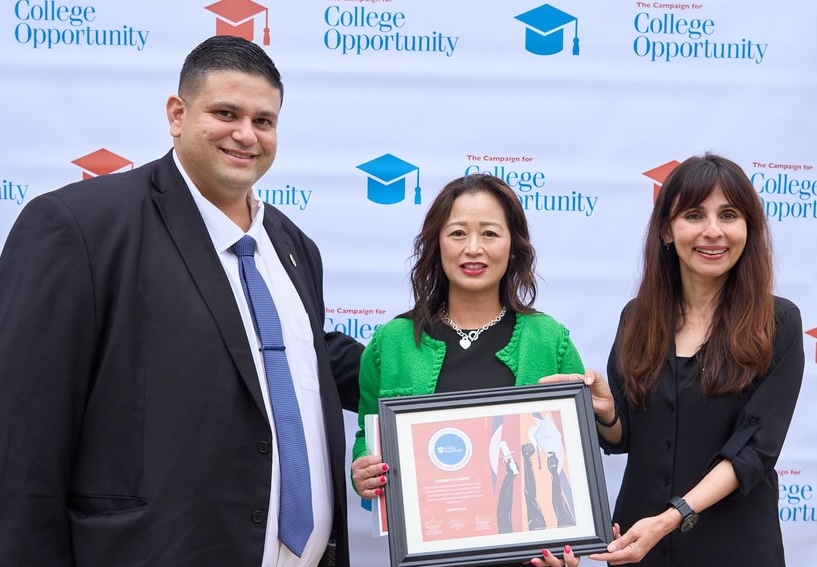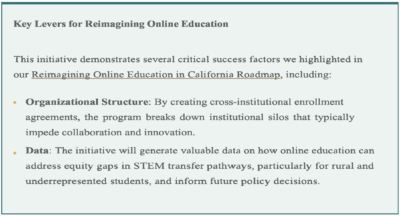The CVHEC Board of Directors and team members convened Aug. 15 at UC Merced for a hybrid strategic planning retreat. Attending in person: (FRONT): Fresno State President Saúl Jiménez-Sandoval; CHSU President Flo Dun; Coalinga College President Carla Tweed; YCCD Interim Chancellor Lena Tran; San Joaquin Delta College Superintendent/ President Lisa Aguilera Lawrenson; Madera Community College President Ángel Reyna; Clovis Community College President Kim Armstrong; Merced College Superintendent/ President Chris Vitelli; CVHEC Dual Enrollment Lead Kristin Clark; UC Merced Chancellor Juan Sánchez Muñoz. (MIDDLE): CVHEC Admin Assistant Priscilla Arellano; Fresno City College President Denise Whisenhunt; Bakersfield College Interim President Stacy Pfluger; Taft College Acting Superintendent/ President Leslie Minor; CVHEC Executive Director Benjamín Durán; Reedley College President Jerry Buckley. (BACK): CVHEC Associate Director Angel Ramirez; WHCCD Chancellor Robert Pimentel; Lemoore College President James Preston; Modesto Junior College President Brian Sanders; Fresno Pacific University President André Stephens; College of the Sequoias President Brent Calvin. (Photo: Juan Rodriguez – UCM).
CVHEC board sets direction for next 3-5 years
with collaborative focus on student success
BY TOM URIBES
CVHEC Communications/Media Lead
Leaders from colleges and universities across California’s Central Valley gathered at the University of California, Merced for a one-day Strategic Planning Retreat hosted by the Central Valley Higher Education Consortium (CVHEC) Board of Directors Aug. 20.
The session marked an important milestone in the consortium’s 23-year history, as presidents, chancellors and higher education CEOs from across the region came together to chart a bold course for the next three to five years, said Dr. Benjamín Durán, CVHEC executive director, .
“This was a ‘roll up your sleeves’ kind of day,” Durán said, reflecting the spirit of the retreat. “It was about open discussion, candid collaboration, and making decisions that will set the state and direction for CVHEC in the years to come.”
A Trusted Voice for Higher Education Advocacy and Collaboration in the Valley
Hosted by UC Merced Chancellor Juan Sánchez Muñoz, the retreat began with welcome remarks that underscored the importance of regional collaboration in advancing higher education opportunities.
The day carried special significance as participants reflected on CVHEC’s origins. Founded at California State University, Fresno under the leadership of President-Emeritus John Welty, the consortium has grown into a trusted voice for higher education advocacy and collaboration in the Valley.
Current Fresno State President Saúl Jiménez-Sandoval noted in a social media post after the event the historical connection he found in reminiscing about his predecessor.
“This is a deeply meaningful program to our university and region,” President Jiménez-Sandoval said. “It represents not just a partnership but a shared responsibility to lift up the Central Valley through education. I look forward to our continued intentional collaboration on so many areas — from AI to transfer pathways to joint research projects.”
The retreat agenda featured a presentation by Durán and Ángel Ramírez, associate director, who revisited CVHEC’s founding story and outlined its core purpose: strengthening higher education access and success across the Central Valley.
“When institutions across the Valley work together, we amplify our impact for students, families, and communities,” said Ramírez, who previewed a draft of a video currently in progress telling the CVHEC story.
Their presentation highlighted the consortium’s current initiatives, including:
- The Central Valley Transfer Project, streamlining student movement between community colleges and universities.
- Expansion of dual enrollment programs.
- And Math alignment efforts including the Math Task Force and CV Math Bridge work.
Dr. Kristin Clark, chancellor -emeritus of the West Hills Community College District participating as a former CVHEC board member, reinforced CVHEC’s uniqueness. She served on the board including as chair until her retirement from WHCCD last year.
“The CVHEC Board of Directors is made up of CEOs. That’s powerful,” she said. “It means we have the ability to drive collective impact at the highest levels of our institutions. We are not duplicating anyone’s work. We are doing what no single institution can do alone. That’s why this board matters.”
Collaborative Workshops: From Challenges to Solutions
Facilitated by Nitya Wakhlu and Greg Netzer of Drawbridge Innovations, the retreat emphasized interaction and problem-solving. Prior to the retreat, board members participated in a survey identifying regional challenges most pressing to their institutions.
During the session, participants divided into small groups to tackle those challenges. Using structured templates, they explored questions such as:
- What is the core challenge we need to solve?
- Who is impacted, and what are we hearing from stakeholders?
- What role should CVHEC play, and how can institutions collaborate?
- What barriers exist, and what resources are needed?
Each group developed a “challenge charter” and presented their ideas to the full board. Using a dot-voting process, members prioritized three to five strategic initiatives for CVHEC to pursue over the next three to five years. Champions were identified for each initiative to ensure follow-through and accountability.
“This is the hard part,” said Wakhlu with a smile. “It’s easy to generate ideas. It’s harder to commit to action. But today you’ve done both.”
“This was the consortium at its best,” Dr. Duran said. “We saw CEOs from across the Valley not only identify shared challenges but also commit to being part of the solution. That’s the spirit of CVHEC.”
Building Toward the Future
The retreat outcomes included:
- Stronger relationships among member CEOs.
- Deeper understanding of CVHEC’s history and ongoing work.
- Clear priorities for regional collaboration.
- Champions stepping up to lead the next phase of CVHEC initiatives.
In addition to the retreat, UC Merced staff offered participants a guided campus tour, showcasing the university’s growth and commitment to serving the Valley.
Reflecting on the day, Associate Director Ramírez expressed optimism for what lies ahead.
“This was more than just planning,” Ramírez said. “It was about reaffirming our shared purpose and commitment in CVHEC’s work. Together, we can expand opportunities and outcomes for every student we serve.







